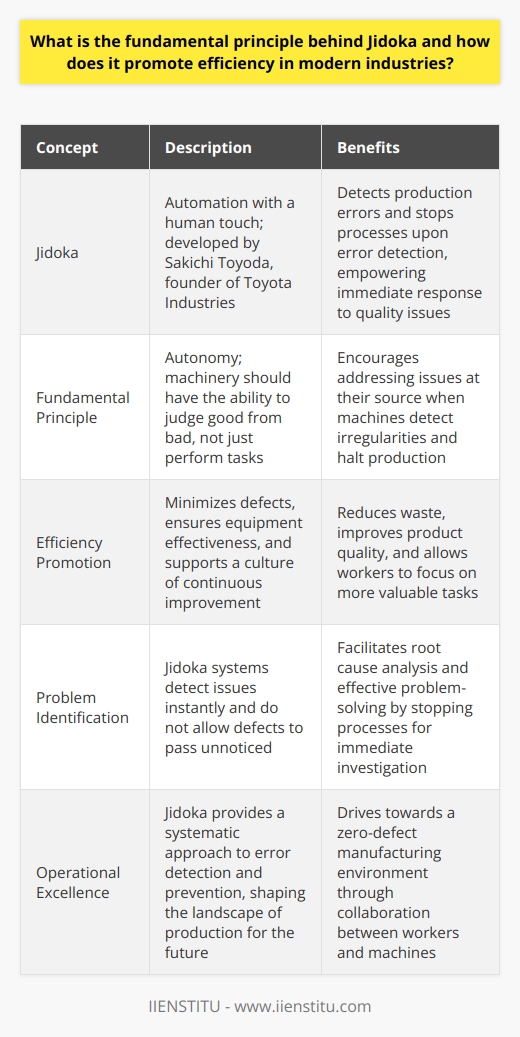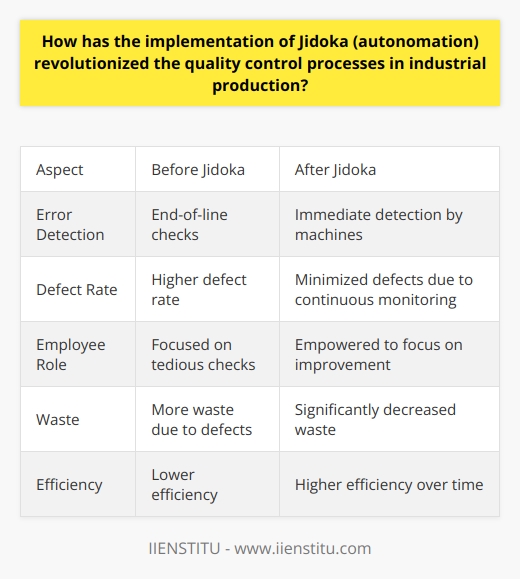
The industrial world is constantly evolving, and with each development, there comes an opportunity to enhance efficiency and productivity. The concept of Jidoka (Autonomation) is one such marvel that combines human intelligence with the precision of machines. This article is designed to provide a comprehensive understanding of Jidoka, its origin, principles, implementation, as well as its challenges and potential. With elements of problem solving skills training and insights into online certificate courses for industrial professionals, the discussion is relevant and enriched with examples.
Understanding Jidoka (Autonomation)
Definition of Jidoka (Autonomation)
Jidoka, often referred to as autonomation, is a key principle of the Toyota Production System that represents automated processes which have a human-like capability to detect errors and stop operations. As a foundational component of lean manufacturing, Jidoka ensures product quality by making abnormalities immediately visible and allowing for immediate corrective action.
Brief History and Origin of Jidoka Concept
The emergence of Jidoka can be traced back to the early 20th century, specifically within the textile industry in Japan. Its inception is credited to Sakichi Toyoda, the founder of Toyota Industries, who developed a loom that would stop automatically when a thread broke, preventing defective products. This allowed a single operator to oversee many machines without compromising quality, laying the groundwork for Jidoka as we understand it today.
Detailed Explanation of Jidoka and its Principles
Jidoka is often simplified as "automation with a human touch," where machines are capable of detecting an issue, halting production, and signaling operators. It is a problem-solving approach that empowers machinery to prevent the continuation of errors.
Key principles include building in quality at the process level, respecting the human workforce by offloading mundane tasks to equipment, and maintaining harmony between human intelligence and mechanical efficiency.
Pareto Chart: A Powerful Tool for Data Analysis and Decision-Making
Quality Improvement: Strategies, Principles, and Impact on Business Success
Failure Mode, Effects, and Criticality Analysis (FMECA): A Comprehensive Guide
The Difference Between Automation and Autonomation
While automation refers to the use of machinery to perform tasks without human intervention, autonomation embellishes this by adding the capability to detect abnormalities and cease operation independent of human monitoring.
This preserves the concept of human control over machinery, where human skills are used more effectively for managing and improving processes.
The Relationship Between Jidoka and the Toyota Production System
Within the Toyota Production System (TPS), Jidoka holds equal standing with Just-in-Time (JIT), the other pillar of TPS. It is indispensable in achieving true operational excellence. By embodying Jidoka, the TPS creates work environments where quality issues are immediately addressed, thereby reducing waste and encouraging a culture of continuous improvement.
The Four Steps of Jidoka
Explanation of the Four-Step Process of Jidoka
The Jidoka process involves four main steps which encourage a proactive stance towards production anomalies. These steps ensure that once a problem is discovered, it is not just corrected but also analyzed for its root cause to prevent future occurrences.
Highlighting Abnormalities
This step involves the machine's ability to detect when something goes awry during operation. The detection mechanisms in place are designed to sense specific issues that could lead to defects, thereby ensuring quality control is embedded in the operation.
Stopping Production
Following the detection, the machine autonomously stops to prevent the propagation of the problem. This builds in a quality check at the source and ensures that no further value is lost through production of defective items.
Fixing the Immediate Condition
After the production halt, operators address the immediate issue to resume operations. This could involve removing the defective piece, recalibrating the machine, or other necessary corrective actions.
Investigating the Root Cause
The final step extends beyond the immediate fix and involves a thorough investigation into why the failure occurred. This can uncover systemic issues and lead to broader improvements in the production process. Techniques such as the "Five Whys" are often employed to drill down to the underlying problem.
Elaboration with Examples for Each Step
For instance, a bottling facility might use sensors to detect if the bottles are filling to the correct level. If the liquid falls below the threshold, sensors trigger the machine to shut down (highlighting abnormalities and stopping production), alerting operators to investigate (fixing the immediate condition). The investigation might reveal a blocked valve which, when corrected, can prevent future occurrences (investigating the root cause).
The Benefits of Jidoka
Increase in Productivity and Efficiency
Jidoka systems streamline processes by delegating quality control to the equipment itself, reducing the need for human oversight and therefore allowing human resources to be directed towards more critical tasks. This enhances productivity and operational efficiency because machines can operate continuously without the risk of producing large quantities of defective goods.
Reduction in Production Defects and Human Error
With Jidoka's built-in detection and response mechanisms, instances of defects due to human error significantly decrease. This also leads to a substantial reduction in waste, which is a fundamental aim of lean manufacturing. By intercepting defects early, Jidoka minimizes the need for costly rework and recalls.
Effect on Employee Morale and Job Satisfaction
The implementation of Jidoka also has a psychological benefit. When employees observe that their company is investing in systems designed to support quality production, it fosters a sense of job security and satisfaction. Moreover, as Jidoka alleviates workers from routine monitoring tasks, they can engage in more fulfilling work, further enhancing morale.
Impact on Cost Savings and Profitability
Jidoka contributes directly to cost savings by reducing the likelihood of extensive repairs, product rework, and warranty claims associated with defects. A company can thereby allocate its resources more effectively, leading to increased profitability and competitive advantage within the market.
Implementation of Jidoka in Various Industries
Jidoka in Manufacturing Industry: Examples and Benefits
In industries such as automotive manufacturing, Jidoka principles are deeply ingrained. Machines equipped with Jidoka technology immediately signal any issue during assembly, ensuring that no vehicle with a defect moves down the line. This attention to detail not only secures reputation for quality but also streamlines the production process.
Jidoka in Service Industry: Examples and Benefits
The concept extends beyond manufacturing. In the service sector, for example, software systems monitor transactions for anomalies, ceasing operations and alerting administrators if fraudulent activity is suspected. By doing so, service providers maintain trust and prevent financial loss.
How Jidoka is Advantageous in the Era of Industry 4.0
As industries move into the realm of Industry 4.0, integrating advanced data analytics and the Internet of Things, Jidoka becomes integral to smart factories. Equipped with sophisticated sensors and predictive analytics, these factories take preemptive action to maintain quality, exemplifying Jidoka on a new, interconnected level.
Challenges in Implementing Jidoka
Potential Difficulties in the Integration Process
Adopting Jidoka can be challenging, as it often requires a fundamental shift in company culture and process design. Organizations need to appreciate the long-term benefits of such systems to endure the short-term upheavals during integration.
Need for Training and Re-skilling
To operate within a Jidoka-embedded environment, the workforce needs to be trained in both the technical aspects and the problem-solving philosophies governing such systems. This might involve in-house training programs or external online certificate courses.
Managing the Initial Cost of Investment
Implementing Jidoka principles often requires significant initial investments in equipment and system updates. Though the long-term benefits can outweigh these costs, businesses need to manage these expenses judiciously.
Throughout this discussion, it is evident that Jidoka or autonomation brings a wealth of benefits to modern industries by embedding quality control directly into production processes. In reviewing the principles, practical steps, and industry applications of Jidoka, as well as considering its challenges, businesses can better appreciate the transformative effects of this methodology.
As industries continue to evolve with advancements in technology and efficiency, the insights provided by Jidoka remain critical. It constitutes an essential element for businesses aiming to enhance their efficiency and sustainability while ensuring the quality and integrity of their products and services.
Frequently Asked Questions
What is the fundamental principle behind Jidoka and how does it promote efficiency in modern industries?
Understanding Jidoka
Jidoka represents a key pillar in lean manufacturing. It translates to "automation with a human touch". This concept finds roots in the early 20th century. Sakichi Toyoda, the founder of Toyota Industries, developed it. Jidoka's primary goal is detecting production errors. It stops processes upon error detection. This empowers immediate response to quality issues.
Jidoka's Fundamental Principle
The fundamental principle behind Jidoka is autonomy. Machinery should have the ability to judge good from bad. Not just perform tasks. When a machine detects an irregularity, it halts production. It then signals operators to intervene. This detection encourages addressing issues at their source.
Efficiency Promotion in Modern Industries
Jidoka promotes efficiency in several ways. First, it minimizes defects. It does this by catching errors at the initial stage. This reduces waste and improves product quality. Second, Jidoka ensures equipment effectiveness. Machines run only when they operate correctly. Third, it supports a culture of continuous improvement. Workers learn from interruptions. They then improve the process.
- Identifies problems instantly: Jidoka systems detect issues right away. They do not allow defects to pass unnoticed.
- Reduces downtime: By stopping only the affected area, other parts continue running. This ensures that downtime remains localized.
- Empowers workers: Employees can focus on more valuable tasks. They do not just monitor machines.
- Improves accountability: Jidoka makes issues immediately visible. Responsibility for quality rises. This leads to a higher commitment to excellence.
- Facilitates root cause analysis: Stopping processes allows for immediate investigation. Teams can then solve problems effectively.
In conclusion, Jidoka's principle of built-in quality control enhances modern industry efficiency. It provides a systematic approach to error detection and prevention. Workers and machines collaborate more effectively. Together, they drive towards a zero-defect manufacturing environment. This strategic approach shapes the landscape of production for the future. Jidoka thus stands as a cornerstone in the pursuit of operational excellence.

How has the implementation of Jidoka (autonomation) revolutionized the quality control processes in industrial production?
The Revolution of Jidoka in Quality Control
Understanding Jidoka
Jidoka, or autonomation, stands as a cornerstone in lean manufacturing. It links human intelligence with automation. This process enables machines to act independently. They stop when detecting quality issues. Human intervention occurs only for problem-solving.
Impact on Industrial Production
Jidoka transforms industrial operations. Machines detect and address defects. They prevent the flow of defective products. This ensures that only high-quality items proceed.
Benefits of Jidoka-Driven Quality Control
Quality control now happens in real-time. This has revolutionized several aspects:
- Immediate Error Detection: Machines stop when a defect arises. This allows for immediate corrective actions.
- Minimized Defects: Continuous monitoring reduces the defect rate.
- Employee Empowerment: Workers focus on improvement, not tedious checks.
- Less Waste: With fewer defects, waste significantly decreases.
- Higher Efficiency: Production lines become more efficient over time.
Implementing Jidoka in industries has forged a new era in manufacturing. It emphasizes proactive quality measures. Machines and workers form a symbiotic relationship. They strive for zero-defect production together.
Quality control once relied on end-of-line checks. It now integrates into each production step. Machines signal issues. Operators respond swiftly. Both work towards perfection.
Jidoka in Action: Case Examples
Many industries have benefitted from this method:
- Automotive: Robots signal anomalies in real-time. Teams resolve issues without delaying production.
- Electronics: Precision is key. Autonomation ensures high-quality circuit boards.
- Pharmaceuticals: Jidoka ensures compliance with stringent regulations. It upholds patient safety.
The Continuous Evolution of Quality Control
Jidoka has not reached its peak. Technological advancements continue to refine it. Artificial intelligence may further enhance error detection. Machine learning could predict maintenance needs.
Quality control is evolving due to Jidoka. It now focuses on preventing defects. It also streamlines processes. This ensures constant improvement.
Conclusion
Jidoka has revolutionized quality control in industrial production. It represents a leap towards flawless manufacturing. With Jidoka, industries operate smarter. They produce higher-quality goods. This brings immense value to consumers and producers alike.

Can you elaborate on the impact of Jidoka on lean manufacturing and how it contributes to reducing waste in production processes?
Jidoka: Its Impact on Lean Manufacturing
Lean manufacturing revolves around waste reduction. At its core, it seeks utmost efficiency. Jidoka, or autonomation, forms a key pillar in this practice.
The Essence of Jidoka
Jidoka grants machines a semblance of autonomy. They stop automatically upon detecting an issue. This feature roots in the Toyota Production System. It places critical emphasis on human intervention only when necessary. Jidoka thus empowers workers to focus on tasks that genuinely require human skills.
Waste Reduction through Jidoka
Jidoka serves multiple functions in eliminating waste. Firstly, it prevents defective products from being completed. This curtails wastage of material. It also saves on labor—workers do not spend time finishing flawed items.
Ensuring Quality at the Source
Quality control becomes proactive with Jidoka. Machines stop at the first sign of a defect. Workers then resolve the root cause. This approach nips potential continuous errors in the bud. It maintains product quality. Manufacturing upholds its standards without compromising on throughput.
Amplifying Human Work
Jidoka elevates human work. Workers engage in problem-solving, not mundane monitoring. They troubleshoot and refine processes. This prevention of overburdening is a principle named *muri* in lean terminology.
Just-In-Time Synergy
Jidoka complements the Just-In-Time (JIT) system. JIT means producing only what is needed, when it is needed. Jidoka ensures what is produced meets quality standards. Both JIT and Jidoka aim for lean, seamless production.
Continuous Improvement Culture
Lean manufacturing thrives on Kaizen, or continuous improvement. Jidoka amplifies Kaizen initiatives. It enables workers to identify and address inefficiencies promptly.
Key Benefits at a Glance
- Stops production when defects occur
- Safeguards against producing waste
- Maintains consistent product quality
- Frees workers for value-adding activities
- Enhances problem-solving capabilities
- Complements JIT for streamlined processes
- Fosters a proactive cultural shift towards improvement
In conclusion, Jidoka marks a vital shift in manufacturing. It transforms processes to be more responsive and less wasteful. By enabling early detection of issues, it saves time, resources, and energy. It forms an integral part of lean manufacturing, driving towards the ultimate goal of efficiency.



